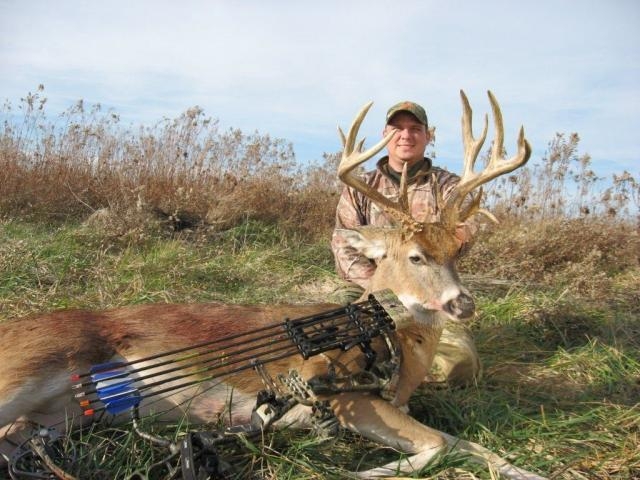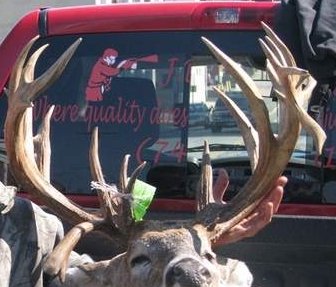Note: Deer & Deer Hunting Editor Dan Schmidt has just returned from a weeklong hunt near Prince Albert, Saskatchewan. This is the second installment of a five-part blog series on his adventure. Check back each day this week for updates.

Over the past two decades, I’ve been chasing trophy whitetails across 18 states and now four Canadian provinces. Some of these big buck hunts have found me pursuing whitetails in the far-reaching forests of Maine, Montana, Wisconsin, Ontario, Alberta and even Quebec’s enchanted Anticosti Island. Without question, last week’s trip to Prince Albert, Saskatchewan ranks at the top of the list for "most wild." Never in my life have I hunted whitetails on such a virgin landscape.
Day 1 of the hunt started uncerimoniously, as I chose to stay back at camp and make sure my CVA Accura’s Konus scope was still "on," while 80 percent of the other hunters headed on their 2-hour excursions toward their stands. We were staying at Garden River Outfitters just outside of the Prince Albert National Forest. This is ground owned by the Canadian government ("Crown" land) that is leased to outfitter Mo Heisler. He has been guiding big-buck fanatics up here since the 1980s. His reputation is unmatched, as is evidenced by photo after photo of smiling hunters kneeling beside B&C-class bucks.
Heisler’s approach is simple. A born trapper, he uses his keen woods knowledge to pinpoint prime deer areas across his 200,000-acre range. Canadians call it "the bush." I call it one endless sea of forest.
"How far does this woods go?" I asked innocently while sitting down at the shooting range to shoot my muzleloader. "I don’t know," Heisler said. "Never really thought about that. Probably all the way to the North Pole," he added I think half-jokingly.
Nestling my cheek into the gunstock, I held a steady grip while centering the cross-hair on the target. KABOOM! Smoke belched out of the fluted Bergara barrel and hung in the 18-degree morning air. My eyes strained to view the paper target through the scope.
"Was there a mark in that bull’s-eye beforehand?" I asked.
"Nope," said Heisler. "Someone will meet you up by the camp house. You’re ready to hunt."
I soon loaded all of my gear into a warm, waiting truck and was headed north with Cal, Mo’s head guide and right-hand man. We drove on snow-packed road that I assumed were paved underneath. And drove. And drove. More than an hour later, we pulled off the road and onto a path that wound through vast expanses of fallow ground. Thirty minutes after that, we approached an endless wall of woodlands.
From there, we loaded my backpack, Heater Body Suit and cased gun onto a waiting ATV.
"Put your facemask on," Cal said. "This ride can get a little cold."
He wasn’t kidding. Seated behind my guide on a one-man Honda Foreman ATV, I held on to the back cargo rack like a bronco rider as we drove countless miles into the gut of a incredibly gorgeous old-growth forest. I’m a tree man by hobby, but I couldn’t quite pinpoint the species I was seeing whiz by us as we drove. However, Cal later told me these woods are populated by mostly white spruce and black poplar. Forty minutes later, the ATV came to an abrupt stop.
"Here we are," Cal whispered while pointing to an Ameristep Outhouse one-man blind buried behind some well-placed spruce bows. "I’ll refresh the bait on the way out. Good luck. See you at dark."
After unloading all of my gear inside the blind and climbing into my Heater Body Suit, I ripped open six extra-large air-activated hand-warmers and stuck them in my pac boots, pant pockets and chest pockets. I then zipped up the blind’s windows, leaving one open just enough to see down the 15-foot wide path to the bait station. That’s all I could see. This woods was so thick that a deer could have walked within 30 yards of the blind in any other direction, and I wouldn’t have seen it.
Although it did seem a bit odd that I had traveled all of these miles to sit in a woods watching a bait pile, I knew full well that this is really the only way to hunt deer in this type of environment and expect to see something. The week’s temperatures called for single-digits. Tracking or still-hunting these whitetails is an admirable fantasy, it would be downright dangerous. Heisler warned us the previous night to not even think about blood-trailing a deer in these woods.
"It’s very easy to get lost out here," Heisler said. "Oh, we’ll find you. But I can’t guarantee that we’ll find you alive."
With those pleasant thoughts dancing in my head, I was more than happy to cast my gaze toward the alfalfa haybale resting in the snow 89 yards in front of my blind in this North Woods jungle.

Click here to read part 3: "That Has Got to Be the BIGGEST Buck I’ve Ever Seen!"
Earlier posts from this series:
Part 1: Big Bucks North of the Border






